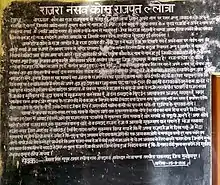Lalotra
The Lalotra is a Hindu Rajput clan found mainly in the Indian states of Punjab, Himachal Pradesh and Jammu and Kashmir. The Lalotra's were also found in Sialkot District, and these Lalotra's immigrated to India at the time of the Partition of India. They are a Dogra sub-group, and their customs are similar to other Dogras.[1][2][3]
Origin
The Lalotra Rajput clan has been emerged from Jasrotia sub-caste of Rajputs, and is considered as a superior Rajput clan of Jammu or Dogra circle.
Raja Lal dev of Jasrotia Rajput clan is known to be the founder of the Lalotra Rajput community also known as the Lion community.

They claim to descend from the Legendary Suryavansha dynasty as descendants of the deity Rama through his son Kusha (Ramayana), because the Dogra Suryavanshi Rajput's origins are actually from the Kachhwaha Rajput clan.[4][5][6]However, historians state that such illustrious descent has no historical basis, and was fabricated by Brahmins in order to give mainly low caste illiterate warriors greater status and prestige in a process called Rajputization. In the process, a Brahmin would somehow "discover" that a budding tribal king descended from an ancient Kshatriya lineage, and the newly declared Rajput would surround himself with the paraphernalia of Brahmanism and become a patron of the Brahmins.[7][8][9][10][11]
See also
References
- "Dogra Rajputs". Footprints in the Snow: On the Trail of Zorawar Singh By G. D. Bakshi
- "Origins and History of Jats and Other Allied Nomadic Tribes of India" by b.s.nijjar
- "People of Jammu-Dogras of Jammu". Webindia123.com. Retrieved 19 January 2012.
- Horace Arhur Rose's "A Glossary of the Tribes and Castes of the Punjab and North West Frontier Province". Vol. III
- "Dogras" complied under the order of the Government of India by Captain A. H. BINGLEY
- "Dogra dynasty | India | Britannica.com". britannica.com. Retrieved 20 August 2015.
- Koyal, Sivaji (1986). "Emergence of Kingship, Rajputization and a New Economic Arrangement in Mundaland". Proceedings of the Indian History Congress. Indian History Congress. 47, I: 536–542. JSTOR 44141600.
- André Wink (2002). Al-Hind, the Making of the Indo-Islamic World: Early Medieval India and the Expansion of Islam 7Th-11th Centuries. BRILL. p. 282. ISBN 0-391-04173-8.
In short, a process of development occurred which after several centuries culminated in the formation of new groups with the identity of 'Rajputs'. The predecessors of the Rajputs, from about the eighth century, rose to politico-military prominence as an open status group or estate of largely illiterate warriors who wished to consider themselves as the reincarnates of the ancient Indian Kshatriyas. The claim of Kshatriyas was, of course, historically completely unfounded. The Rajputs as well as other autochthonous Indian gentry groups who claimed Kshatriya status by way of putative Rajput descent, differed widely from the classical varna of Kshatriyas which, as depicted in literature, was made of aristocratic, urbanite and educated clans...
- Norman Ziegler (1976). David Henige (ed.). "History in Africa (vol.3)". African Studies Association: 150.
: Rajputs were, with some exceptions, almost totally illiterate as a caste group
Cite journal requires|journal=(help) - Reinhard Bendix (1998). Max Weber: An Intellectual Portrait. Psychology Press. pp. 180–. ISBN 978-0-415-17453-4.
- Brajadulal Chattopadhyaya (1994). "Origin of the Rajputs: The Political, Economic and Social Processes in Early Medieval Rajasthan". The Making of Early Medieval India. Oxford University Press. p. 59. ISBN 9780195634150.